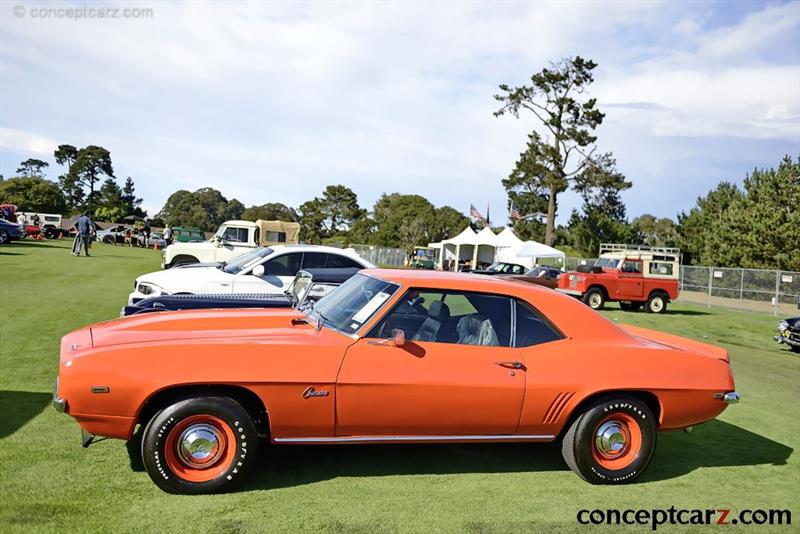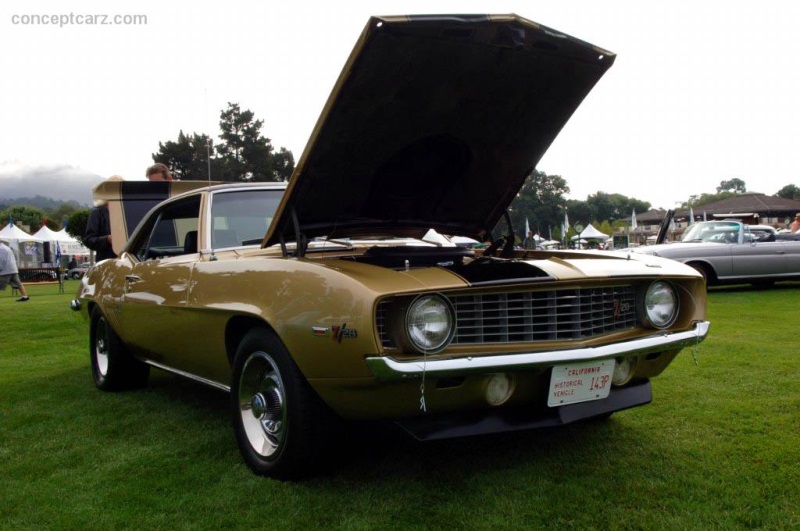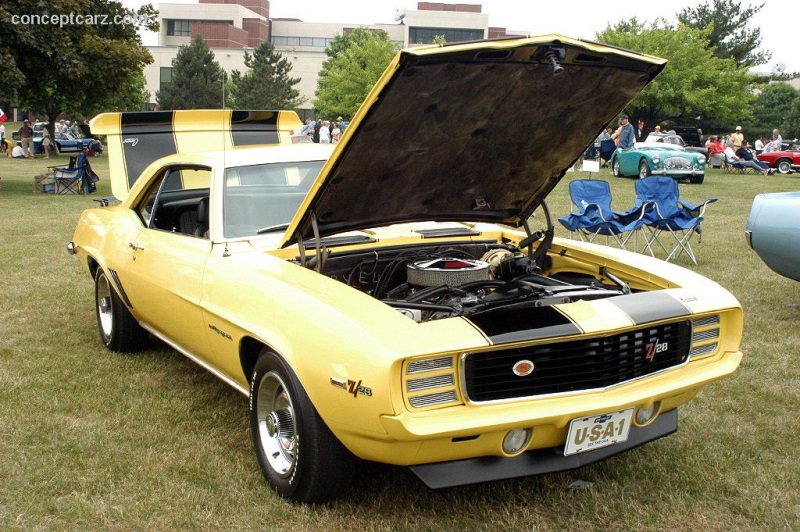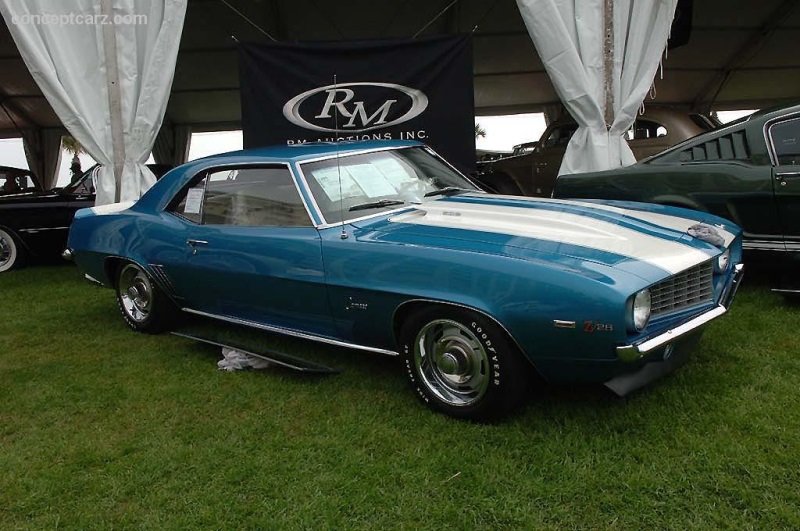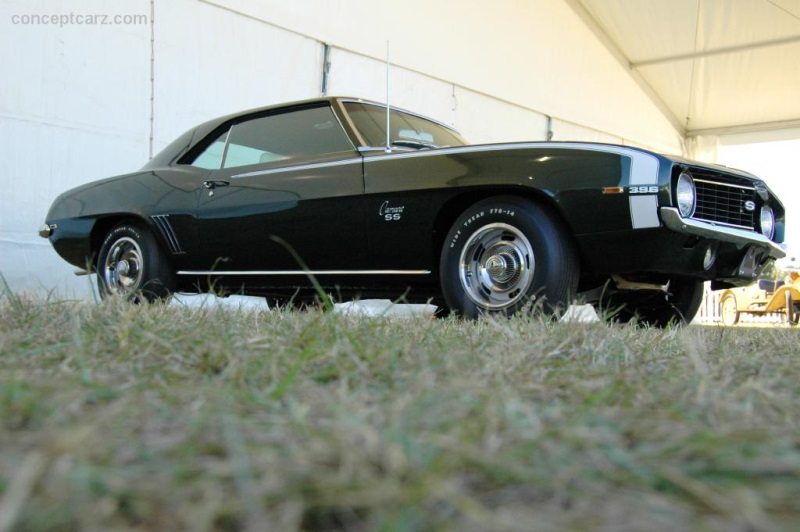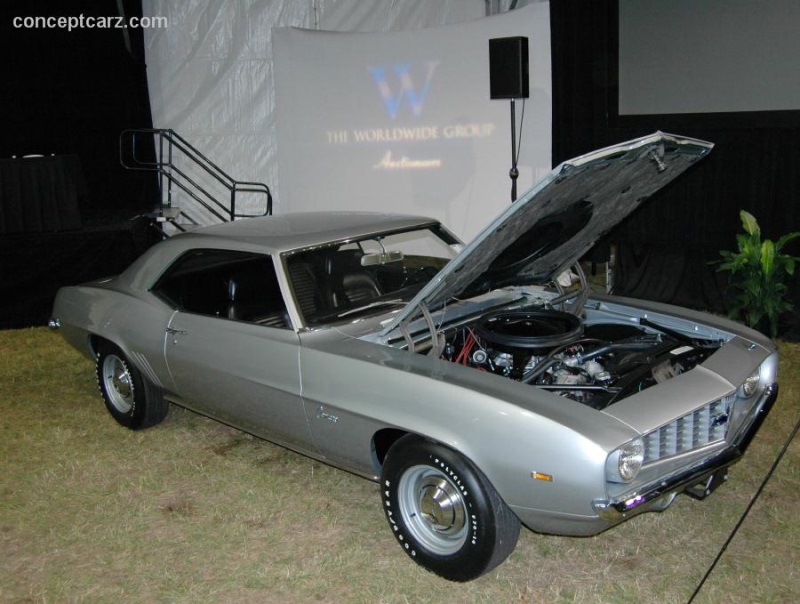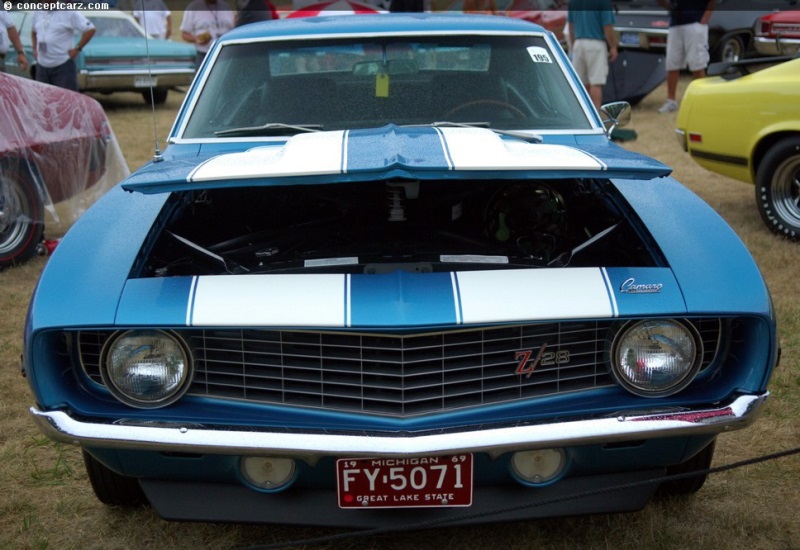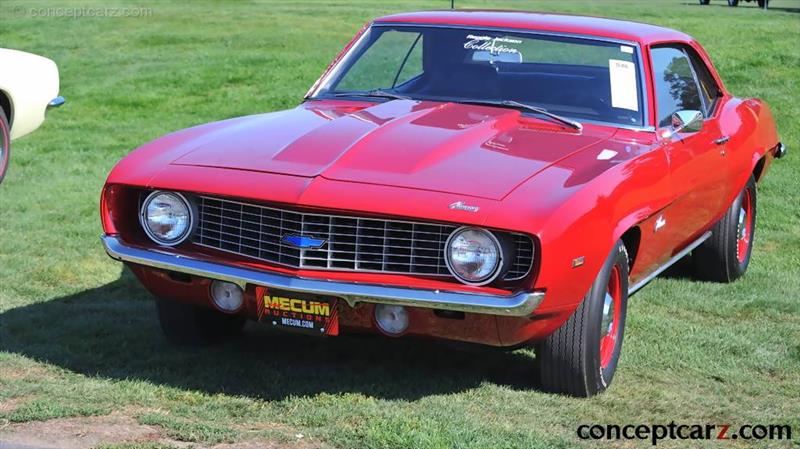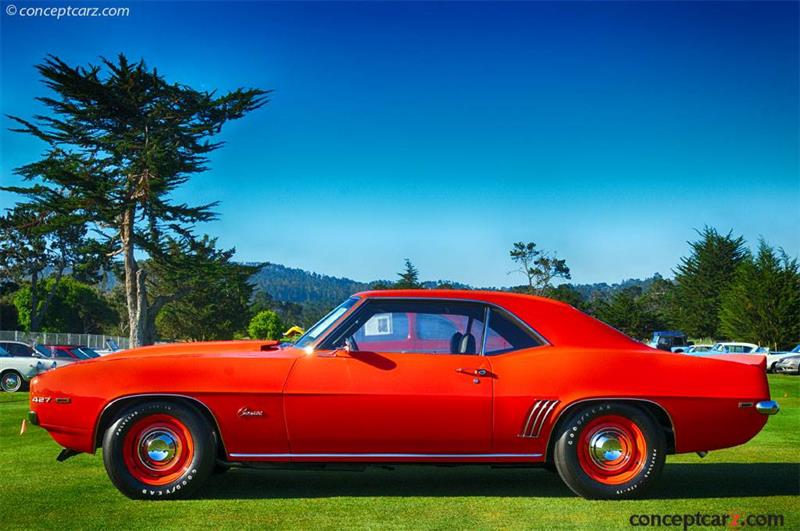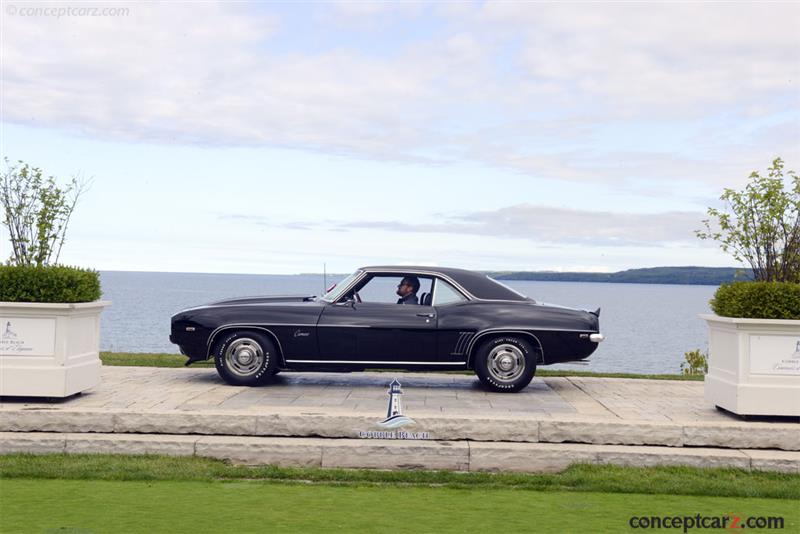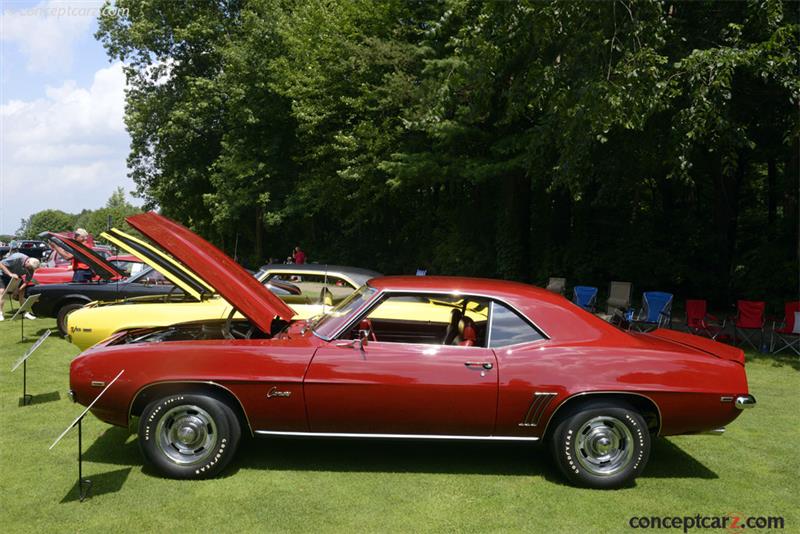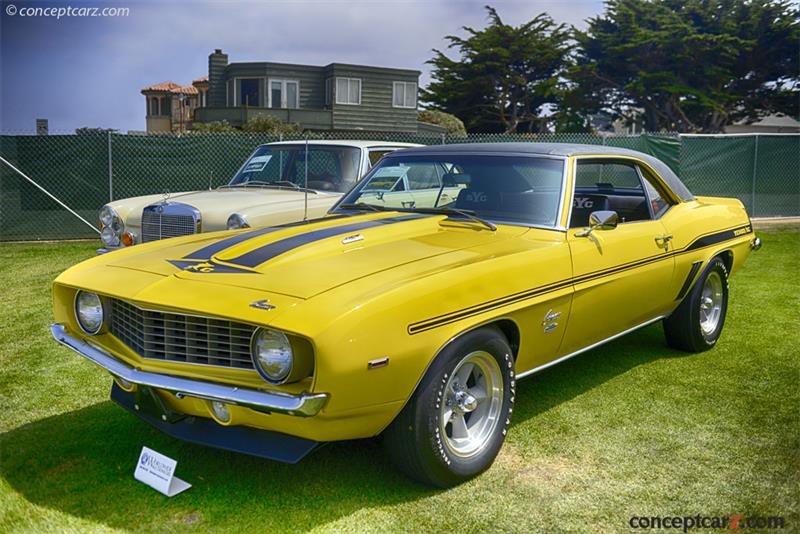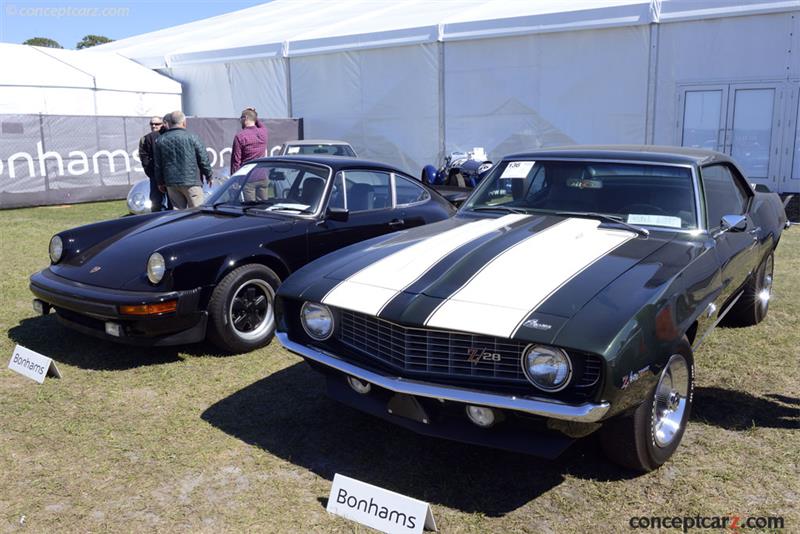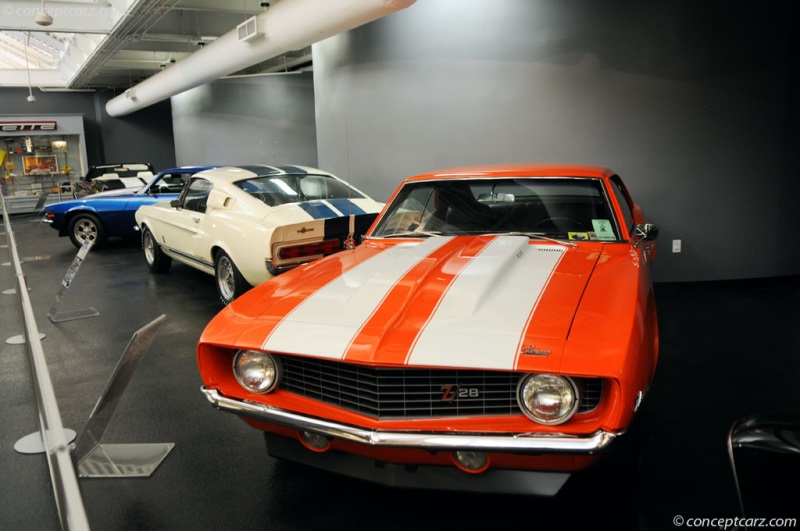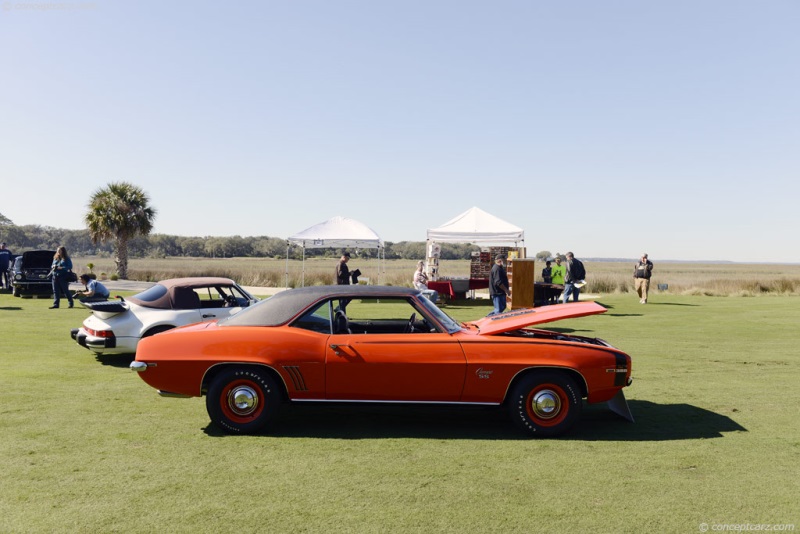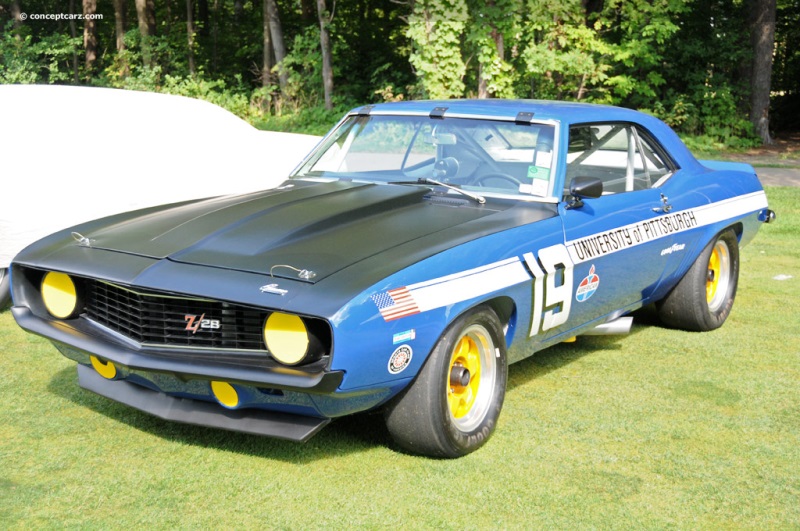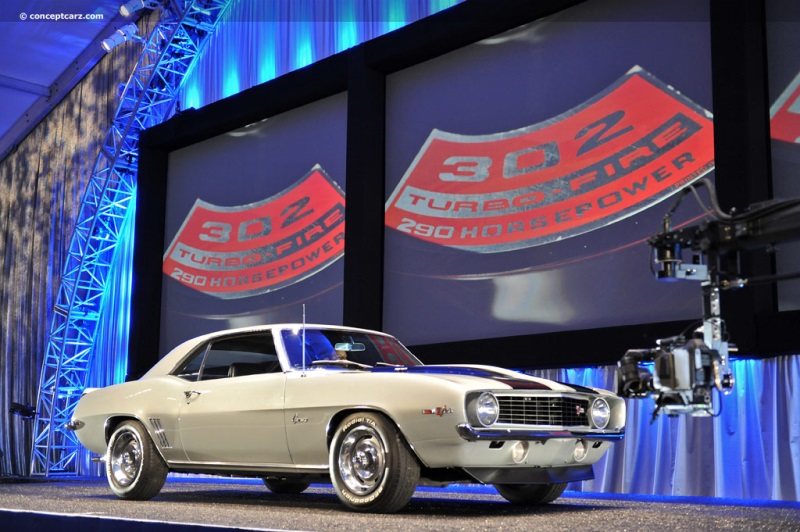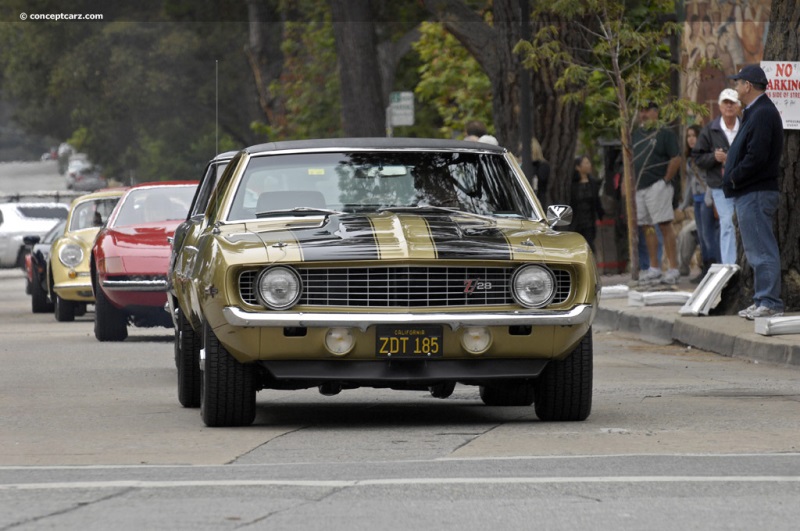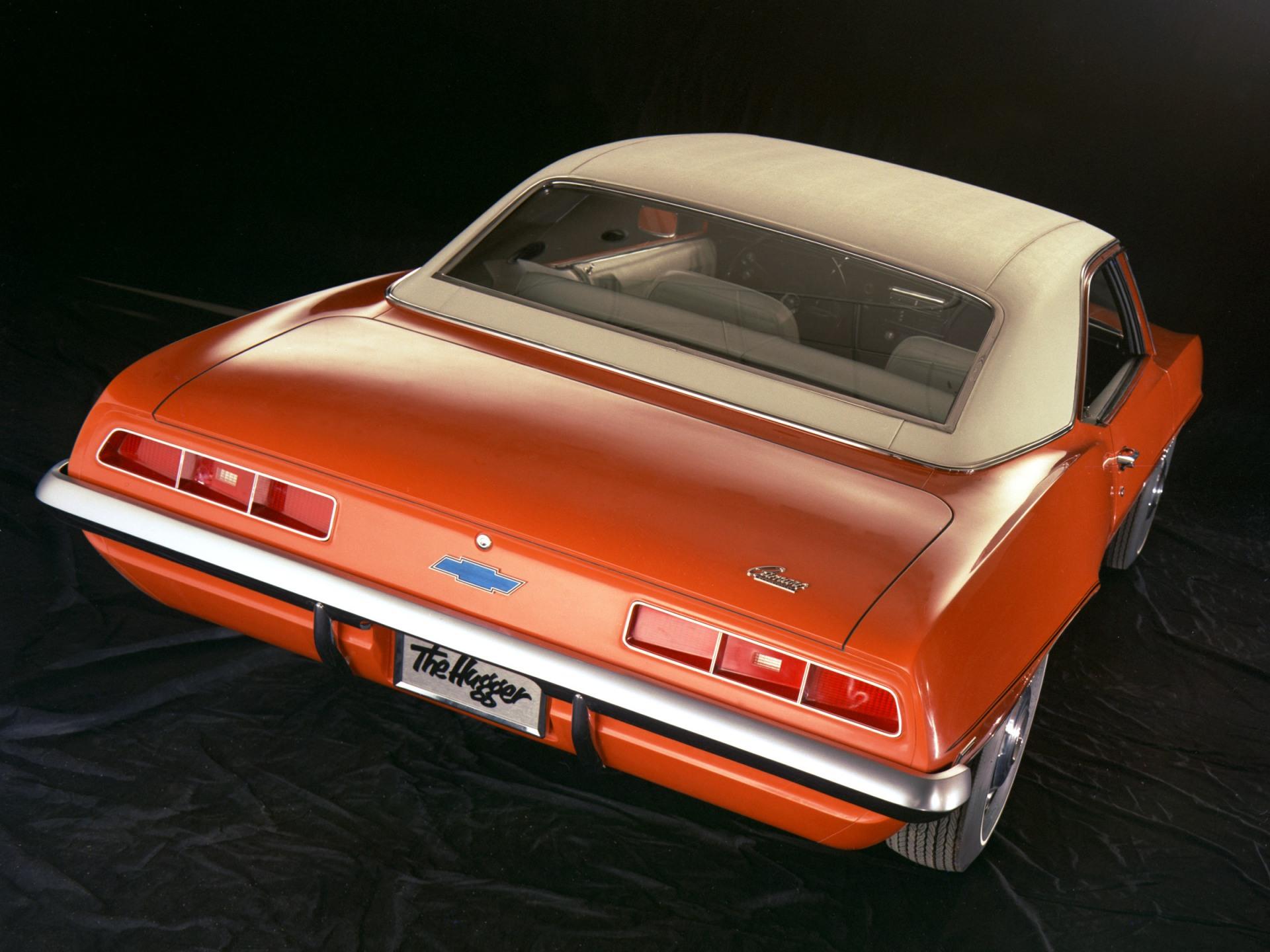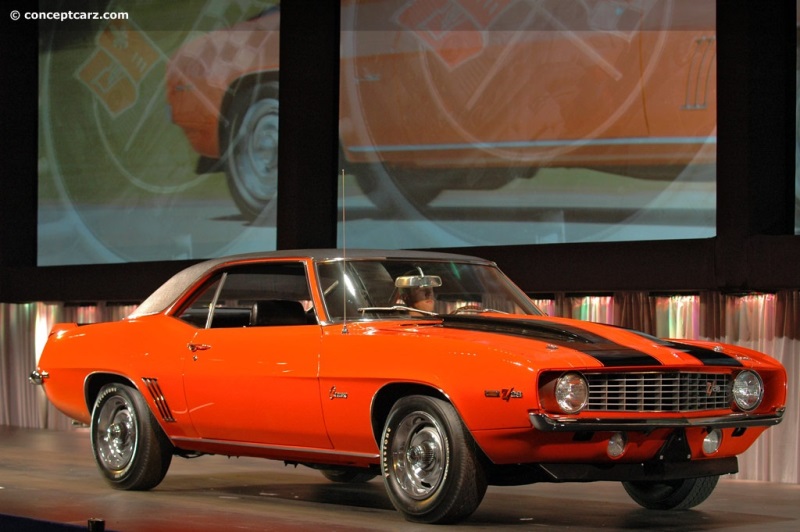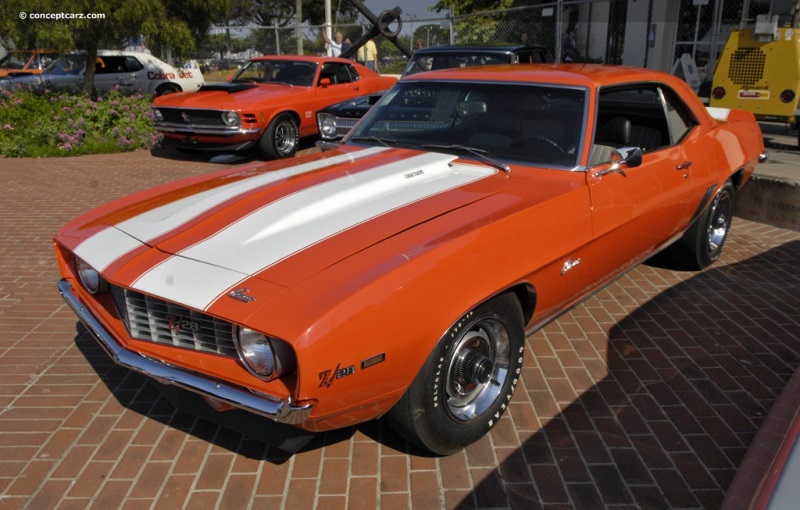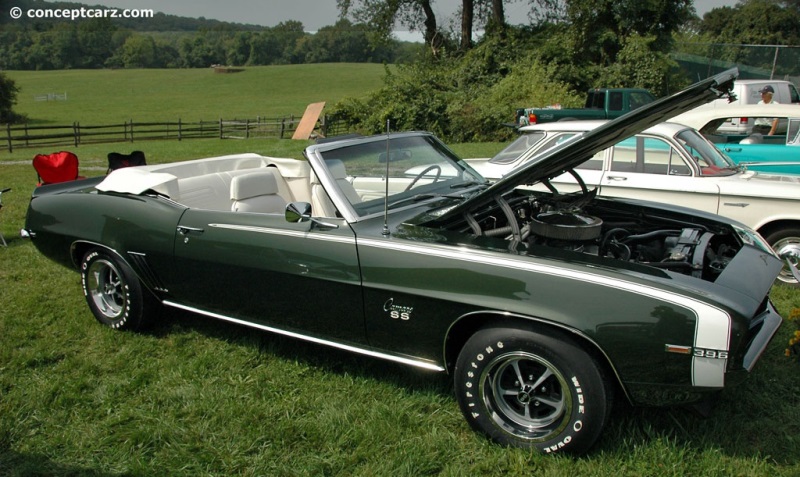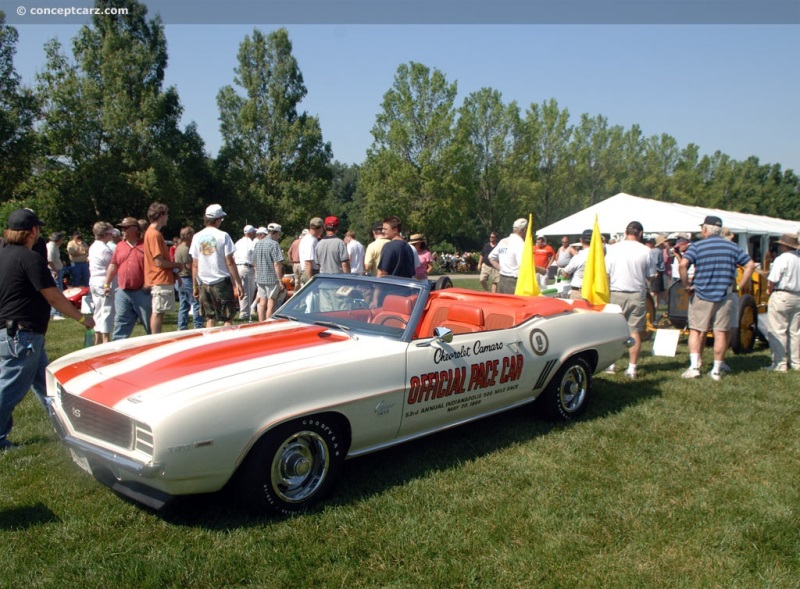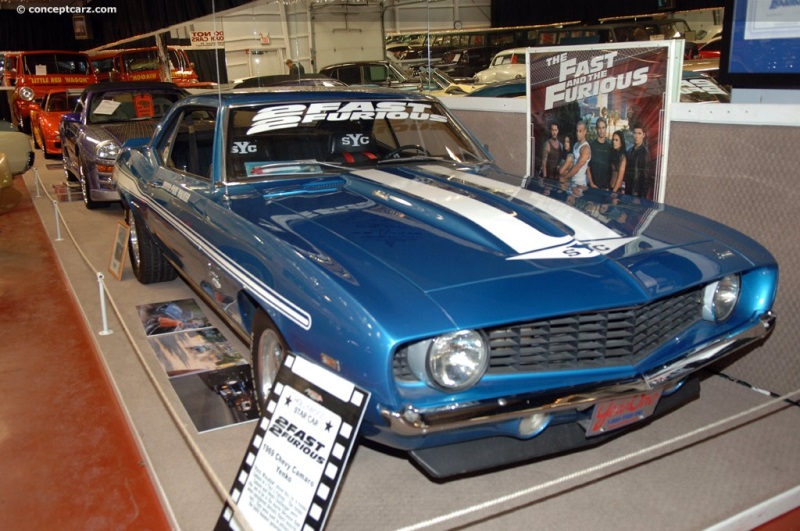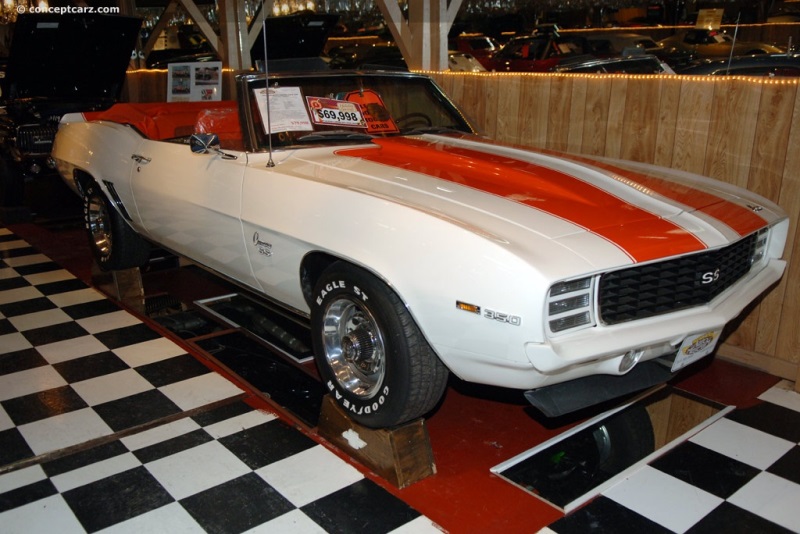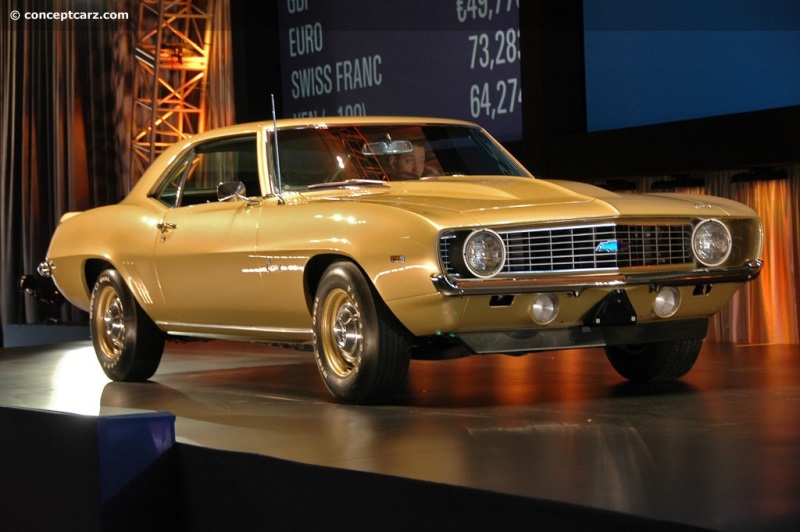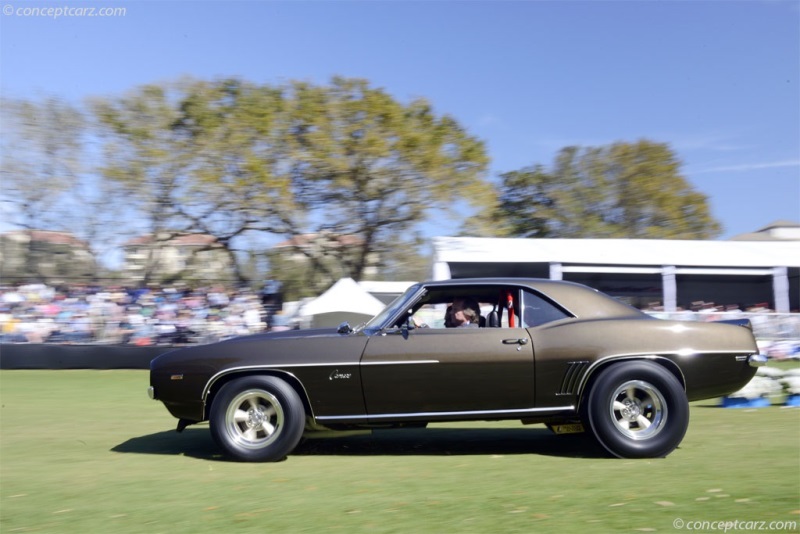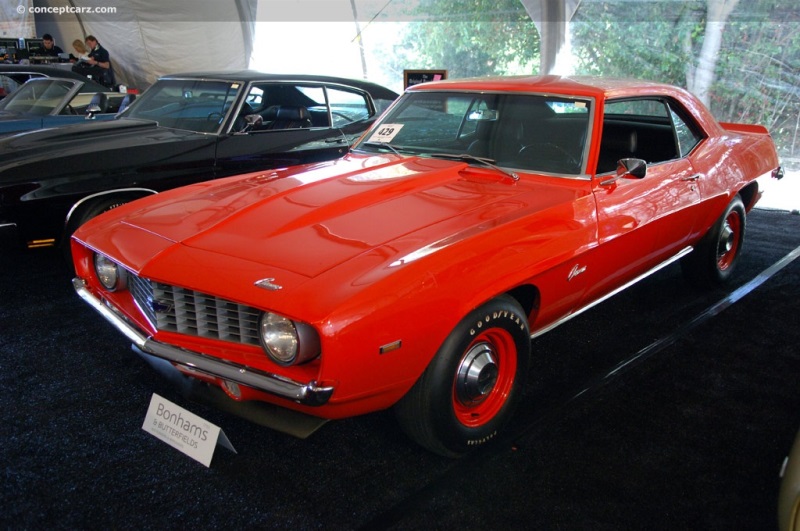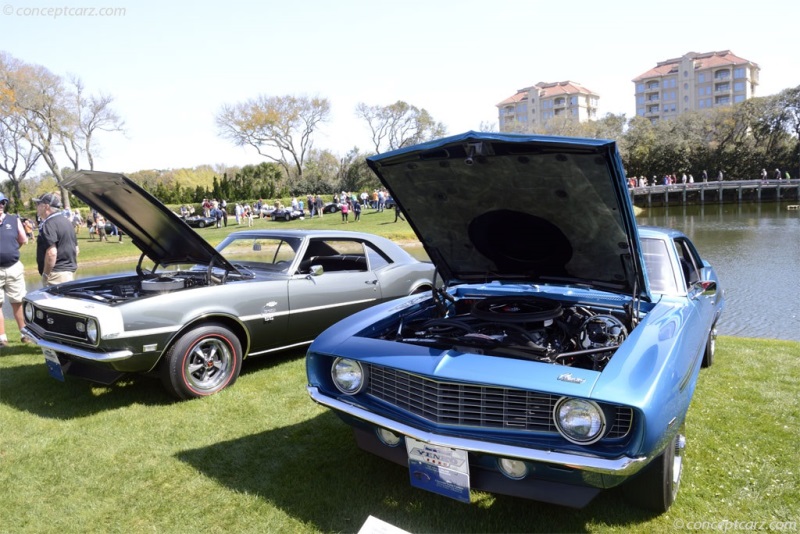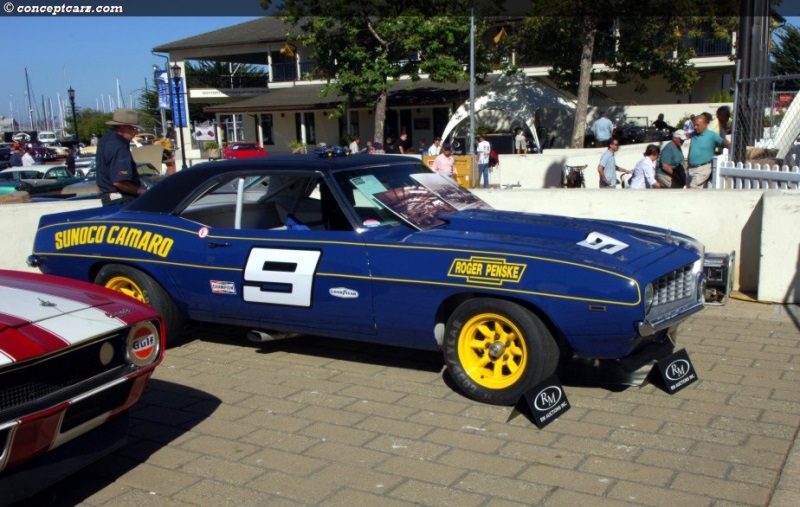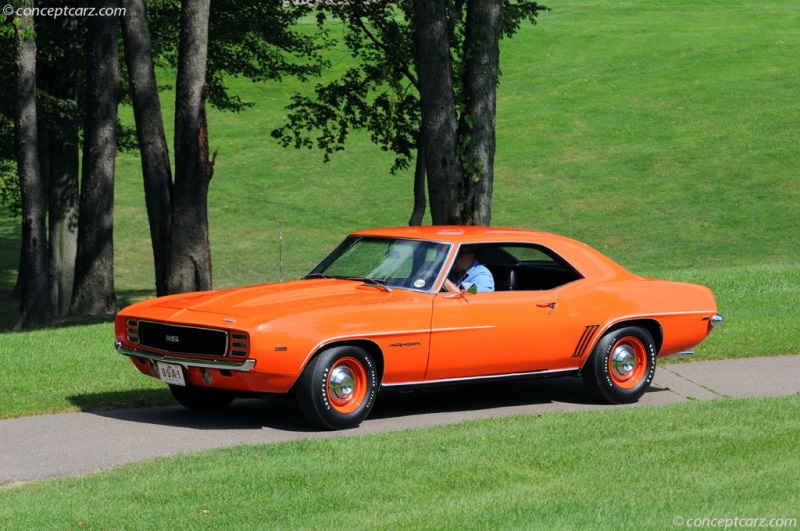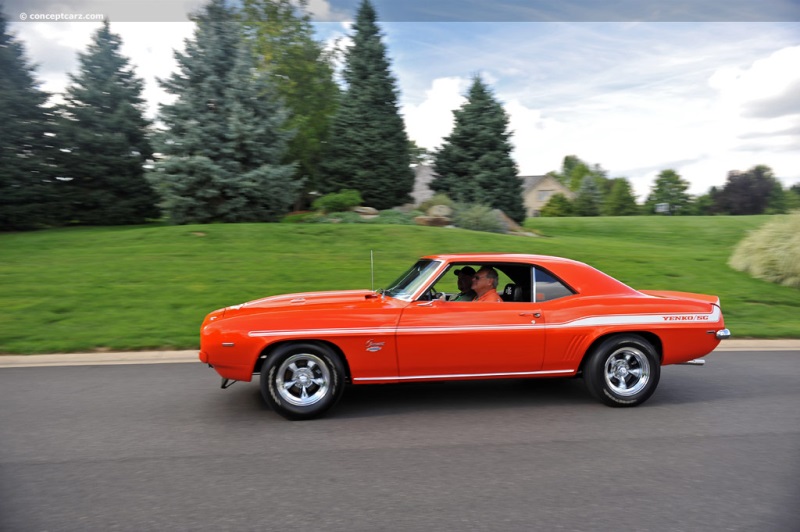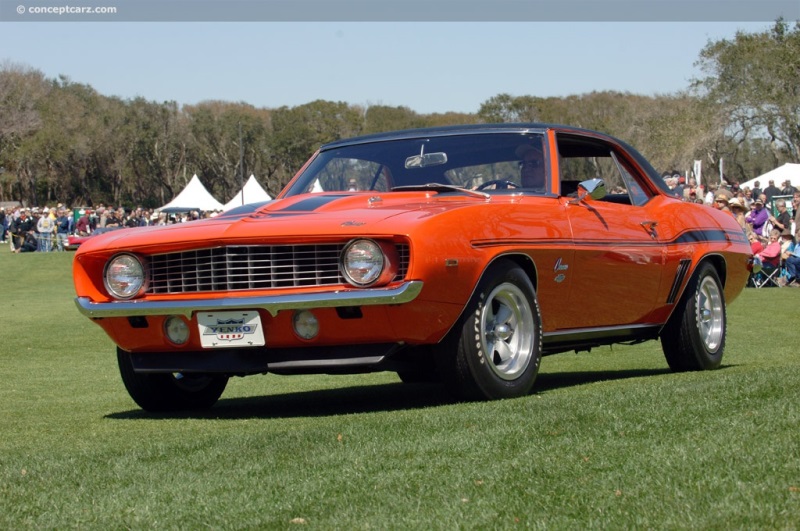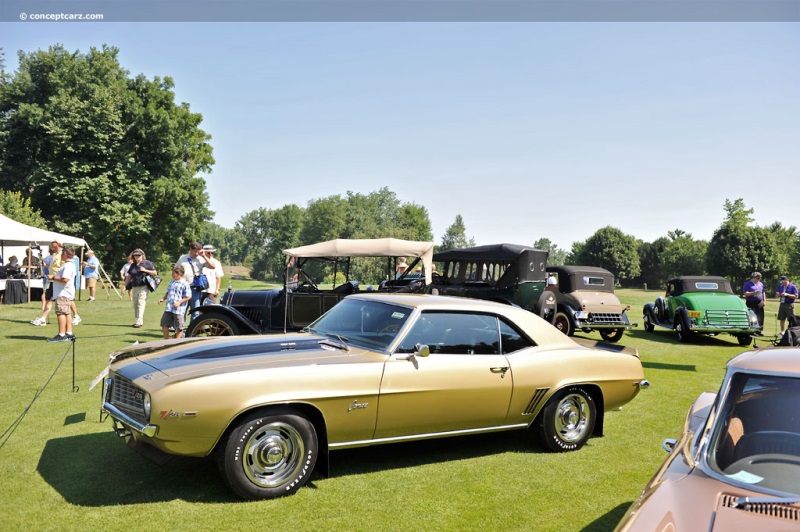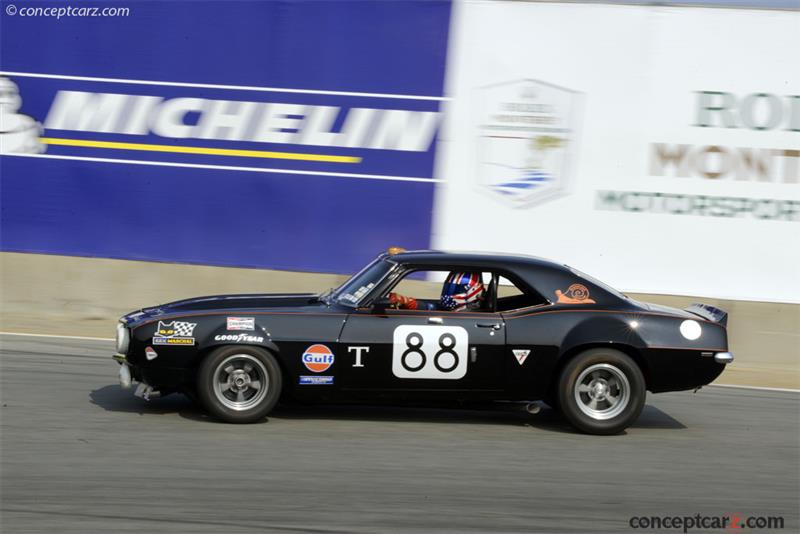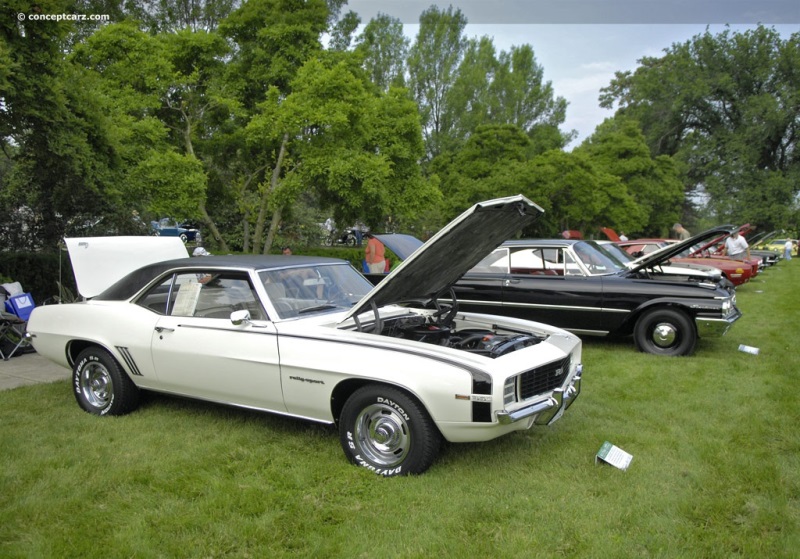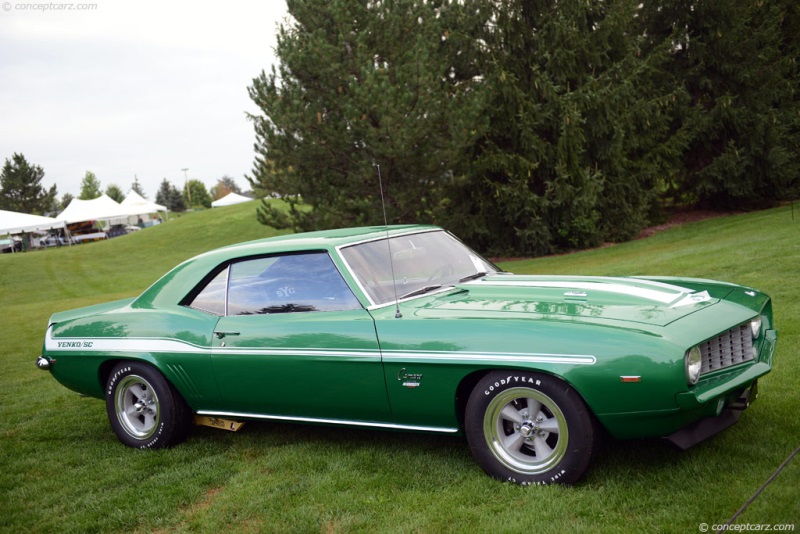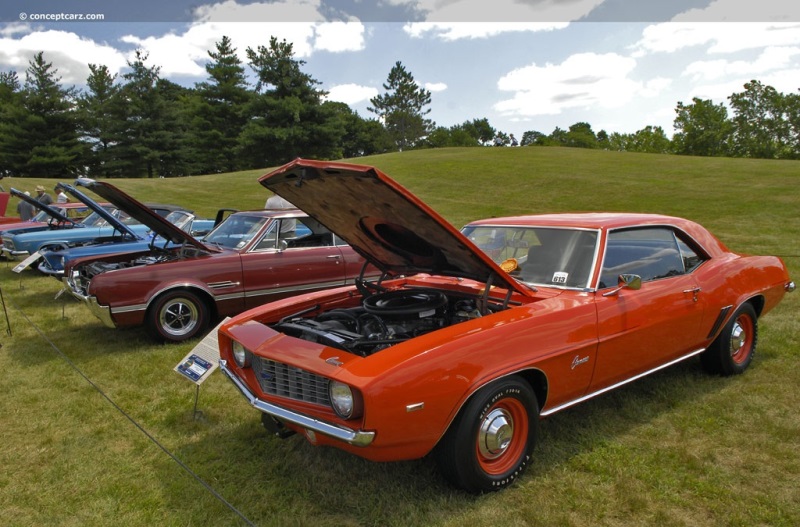1969 Chevrolet Camaro Navigation
The 1969 Chevrolet Camaro was part of the first-generation 'F-Body' and by this point in history, had truly come of age, with handsome styling, huge option lists, brilliant racing success, and strong showroom sales. The new 1969 body was lower and longer in appearance, measuring 166 inches in length with a 112-inch wheelbase. Body styles included a sport coupe and convertible. The Rally Sport option came with concealed headlights, retractable headlamp doors with a triple-slot design, and a black grille. The Z/28 and Super Sport (SS) packages had the 'Super Scoop' hood.
Standard equipment included a heater, defroster, Strato-Bucket front seats, all-vinyl interior, Astro Ventilation system, left-hand outside rearview mirror, front shoulder safety belts, and a six-cylinder engine rated at 140 horsepower. The standard V8 brought horsepower to 210 hp. The ZL-1 option had the 427 cubic-inch V8 engine with aluminum block construction and produced 425 horsepower.
Hardtop Sport CoupeRally Sport (RS)
The Rally Sport was an appearance package that could be added to the Super Sport or the Z28. A total of 37,773 examples of the 1969 Camaro were fitted with this option. The Rally Sport added 'RS' badges, special stripes and wheels, and unique slotted headlight covers that lifted when the lights were turned on. If the cover failed to rise, the light would still shine through the slots. The interiors received special bucket seats and nicer carpeting. Super Sport (SS)
The Super Sport came with a 396 cubic-inch 'big block' V8 engine with up to 375 horsepower. They were 'SS' badges on the fenders and on the front and rear deck. A 'bumblebee strip' traveled across the front of the hood, and there were simulated air intakes on the hood. Z/28
The RPO Z/28 option package had been introduced in 1967 to homologate the car for racing. Refinements for 1968 and 1969 further enhanced the concept. Power was from a small-block V8 engine, combining the basic dimensions of the 327-cylinder block and short-stroke 283 crank to yield 302 cubic inches. This was just under the SCCA-mandated displacement limit for Trans-Am racing. Additional race-bred modifications maximized the Z/28's factory-underrated 290 horsepower output.
The racing versions were successfully campaigned by Penske Racing and piloted by star driver Mark Donohue to back-to-back SCCA Trans-Am championships in 1968 and 1969. Additionally, the Z/28 was formidable on the dragstrip, with the 1969 Z/28 being a 14-second car in stock trim with low-13s when fitted with narrow slicks, lower rear-end gears (3.73:1), tuning, and open headers.Indianapolis 500 Pace Car
1969 was the final year for the first-generation Camaro. The first-gen Camaro had paced the 1967 Indianapolis '500' and NASCAR's signature race, the Daytona '500,' in 1968 and 1969. It returned in 1969 as the Official Pace Car for the Indianapolis 500 race and Festival celebrations, wearing a high-visibility Dover White paint finish, matching convertible top, Z/28-style Hugger Orange stripes, and Orange Houndstooth upholstery. Two specially equipped Official Pace Cars were constructed, plus one show-car replica, to be presented to the winner of the venerable race. An additional 130 cars were produced to serve as support vehicles for the use of officials, VIPs, and journalists. The public was also able to purchase an Official Pace Car Edition Camaro. Dealers could order RPO (Regular Production Order) Z11 and get a Camaro RS/SS in the same color combination as the pace and festival cars, plus the all-new ZL2 Cowl Induction hood. The base car had a three-speed manual transmission with the SS350 engine but could be further upgraded with the RPO L35 396 cubic-inch Turbo-Jet engine and choice of transmission. The 'Official Pace Car' dealers for the doors were placed inside the car and the buyer to install them at their discretion. Although Chevrolet planned to have examples sent to nearly all of the 6,400 Chevrolet dealers across the country, just 3,764 examples were produced and sold at a suggested base price of $3,700. Production numbers by engine size are not known, but it is estimated that about 735 of the Pace Car Edition were fitted with the 396 'big-block' engine option.Yenko SYC Camaro
Don Yenko was a Chevrolet dealer and performance enthusiast from Pennsylvania. He installed Corvette's 427 cubic-inch V8 engine into new Camaros and convinced Chevy personnel to approve a factory-built 427 for 1969 using the Central Office Production Order. These 'COPO' orders were typically reserved for fleets.
Hardtop Sport Coupe
View info and historyCOPO 9561 came with a factory L72 427 boasting solid lifters and (a widely understated) 425 horsepower with 4.10 gearing. Additional upgrades included a special ducted hood and heavy-duty cooling; power front disc brakes and an optional transmission were mandatory. COPO 9737, the Sport Car Conversion Kit, included 15-inch tires on Rally Wheels, a 140 mph speedometer, and a 13/16 inch front stabilizer bar. GM also offered COPO code 9560 for drag racing with an all-aluminum ZL1. That engine alone cost $4,000, nearly twice the cost of a base vehicle.Other dealerships quickly realized the little-publicized ordering loophole and approximately 1,015 street-legal Camaros received the L72 COPO option. Around 201 Yenko Camaros were produced in 1969. ZL1
Fred Gibb was another Chevrolet dealer who convinced General Motors to create an all-aluminum version of the 427 cubic-inch engine. Intended for Super Stock drag racing, the fifty examples were needed to satisfy National Hot Rod Association homologation rules. Gibbs received all fifty cars and other dealers across the country received nineteen more.
Hardtop Sport Coupe
View info and historyThese heavily optioned cars came with the Rally Sport package and beefed-up brakes and suspension to cope with the 430 horsepower all-aluminum 427 CID V8. The price for the ZL1 package was $7,269.Production and Pricing
1968 Camaro
Chevrolet produced 159,087 examples of the 'base,' 40,977 of the RS, 27,884 of the SS, and 7,199 examples of the Z28. The total 1968 Chevy Camaro production was 235,147 units, which represented an increase over the 1967 production figure of 220,906 units.
Hardtop Sport Coupe
View info and historyThe hardtop sport coupe had a base price of $2,640 with the standard six-cylinder engine and $2,730 with the standard eight. The two-door convertible had a base price of $2,850 with the six-cylinder engine and $2,940 with the standard eight-cylinder unit. 1969 Camaro
In 1969, Chevrolet produced 150,078 examples of the 'base,' 37,773 of the 'RS,' 34,932 of the SS, and 20,302 of the Z28. The total production of 1969 Camaros was 243,085 units, which represented an increase of nearly 8,000. Due to manufacturing problems that delayed the introduction of the second-generation model planned for 1970, the 1969 model year was longer than usual, extending into November 1969.Mechanical Specifications
Dimensions
The 1969 Chevy Camaro had a wheelbase size of 108 inches, a length of 186 inches, a width of 74 inches, and stood 51.1 inches tall (the convertible was 50.9 inches tall). Updates
The mounting for the rear shock absorber was staggered to resolve wheel hop issues on the 1968 Camaros, and examples with high-performance engines had received multi-leaf rear springs instead of the single-leaf unit.Engines
The 230 cubic-inch inline six-cylinder engine had overhead valves, a cast iron block, hydraulic valve lifters, seven main bearings, and a Rochester one-barrel carburetor. With 8.5:1 compression, it delivered 140 horsepower at 4,400 RPM and 220 lb-ft of torque.
Hardtop Sport CoupeThe 250 cubic-inch inline six-cylinder engine with a one-barrel carburetor produced 155 horsepower at 4,200 RPM and 235 lb-ft of torque at 1,600 RPM. The 1969 Camaro's eight-cylinder engines had overhead valves, hydraulic valve lifters, and five main bearings. Most had a cast iron block and cylinder head, with the 396 and 427 capable of being fitted with an aluminum block and heads.The 302 cubic-inch small-block V8 engine used in the Z28 had a four-barrel Holley carburetor and delivered 290 horsepower at 5,800 RPM and 290 lb-ft of torque at 4,200 RPM. It had 11:1 compression, a forged steel crankshaft and connecting rods, forged pistons, and a solid lifter camshaft. A dealer-installed dual four-barrel cross-ram intake manifold was optional. With the Z28 option, this engine was backed by a Muncie four-speed transmission with a new-for-1969 standard Hurst shifter matted to a 12-bolt rear axle with standard 3.73 gears. 
Hardtop Sport Coupe
View info and historyThe 307 cubic-inch V8 engine with a two-barrel carburetor produced 200 horsepower at 4,600 RPM and 300 lb-ft of torque at 2,400 RPM.The 326.7 cubic-inch V8 engine with a Rochester two-barrel carburetor and 8.75:1 compression delivered 210 horsepower at 4,000 RPM and 320 lb-ft of torque at 2,400 RPM. With a four-barrel carburetor, this engine (L30) delivered 275 horsepower at 4,800 RPM and 335 lb-ft at 3,200 RPM. Three versions of the 350 cubic-inch V8 were offered, with the two-barrel version delivering either 250 horsepower or 255 horsepower and the four-barrel producing 300 horsepower at 4,800 RPM and 380 lb-ft of torque at 3,200 RPM.
Hardtop Sport Coupe
View info and historyThe 396 cubic-inch Turbo-Jet 'big block' V8 engine had four-barrel carburetion and delivered 325 horsepower at 4,800 RPM and 410 lb-ft @ 3,200 RPM for the L35, the L34 version produced 350 hp @ 5200 rpm and 415 lb-ft @ 3400 rpm, and the L78/L79 delivered 375 hp @ 5600 rpm and 415 lb-ft @ 3,600 RPM. The range-topping L72 (COPO 9561) four-barrel 427 cubic-inch V8 produced 425 horsepower at 5,400 RPM and 460 lb-ft of torque at 3,600 RPM. The ZL1 (COPO 9560) had an aluminum block and cylinder heads, slightly higher compression (12.5:1 compared to 12.0:1) with 430 horsepower and 450 lb-ft of torque.
by Daniel Vaughan | Aug 2019
Standard equipment included a heater, defroster, Strato-Bucket front seats, all-vinyl interior, Astro Ventilation system, left-hand outside rearview mirror, front shoulder safety belts, and a six-cylinder engine rated at 140 horsepower. The standard V8 brought horsepower to 210 hp. The ZL-1 option had the 427 cubic-inch V8 engine with aluminum block construction and produced 425 horsepower.

Hardtop Sport Coupe
The Rally Sport was an appearance package that could be added to the Super Sport or the Z28. A total of 37,773 examples of the 1969 Camaro were fitted with this option. The Rally Sport added 'RS' badges, special stripes and wheels, and unique slotted headlight covers that lifted when the lights were turned on. If the cover failed to rise, the light would still shine through the slots. The interiors received special bucket seats and nicer carpeting. Super Sport (SS)
The Super Sport came with a 396 cubic-inch 'big block' V8 engine with up to 375 horsepower. They were 'SS' badges on the fenders and on the front and rear deck. A 'bumblebee strip' traveled across the front of the hood, and there were simulated air intakes on the hood. Z/28
The RPO Z/28 option package had been introduced in 1967 to homologate the car for racing. Refinements for 1968 and 1969 further enhanced the concept. Power was from a small-block V8 engine, combining the basic dimensions of the 327-cylinder block and short-stroke 283 crank to yield 302 cubic inches. This was just under the SCCA-mandated displacement limit for Trans-Am racing. Additional race-bred modifications maximized the Z/28's factory-underrated 290 horsepower output.
The racing versions were successfully campaigned by Penske Racing and piloted by star driver Mark Donohue to back-to-back SCCA Trans-Am championships in 1968 and 1969. Additionally, the Z/28 was formidable on the dragstrip, with the 1969 Z/28 being a 14-second car in stock trim with low-13s when fitted with narrow slicks, lower rear-end gears (3.73:1), tuning, and open headers.Indianapolis 500 Pace Car
1969 was the final year for the first-generation Camaro. The first-gen Camaro had paced the 1967 Indianapolis '500' and NASCAR's signature race, the Daytona '500,' in 1968 and 1969. It returned in 1969 as the Official Pace Car for the Indianapolis 500 race and Festival celebrations, wearing a high-visibility Dover White paint finish, matching convertible top, Z/28-style Hugger Orange stripes, and Orange Houndstooth upholstery. Two specially equipped Official Pace Cars were constructed, plus one show-car replica, to be presented to the winner of the venerable race. An additional 130 cars were produced to serve as support vehicles for the use of officials, VIPs, and journalists. The public was also able to purchase an Official Pace Car Edition Camaro. Dealers could order RPO (Regular Production Order) Z11 and get a Camaro RS/SS in the same color combination as the pace and festival cars, plus the all-new ZL2 Cowl Induction hood. The base car had a three-speed manual transmission with the SS350 engine but could be further upgraded with the RPO L35 396 cubic-inch Turbo-Jet engine and choice of transmission. The 'Official Pace Car' dealers for the doors were placed inside the car and the buyer to install them at their discretion. Although Chevrolet planned to have examples sent to nearly all of the 6,400 Chevrolet dealers across the country, just 3,764 examples were produced and sold at a suggested base price of $3,700. Production numbers by engine size are not known, but it is estimated that about 735 of the Pace Car Edition were fitted with the 396 'big-block' engine option.Yenko SYC Camaro
Don Yenko was a Chevrolet dealer and performance enthusiast from Pennsylvania. He installed Corvette's 427 cubic-inch V8 engine into new Camaros and convinced Chevy personnel to approve a factory-built 427 for 1969 using the Central Office Production Order. These 'COPO' orders were typically reserved for fleets.
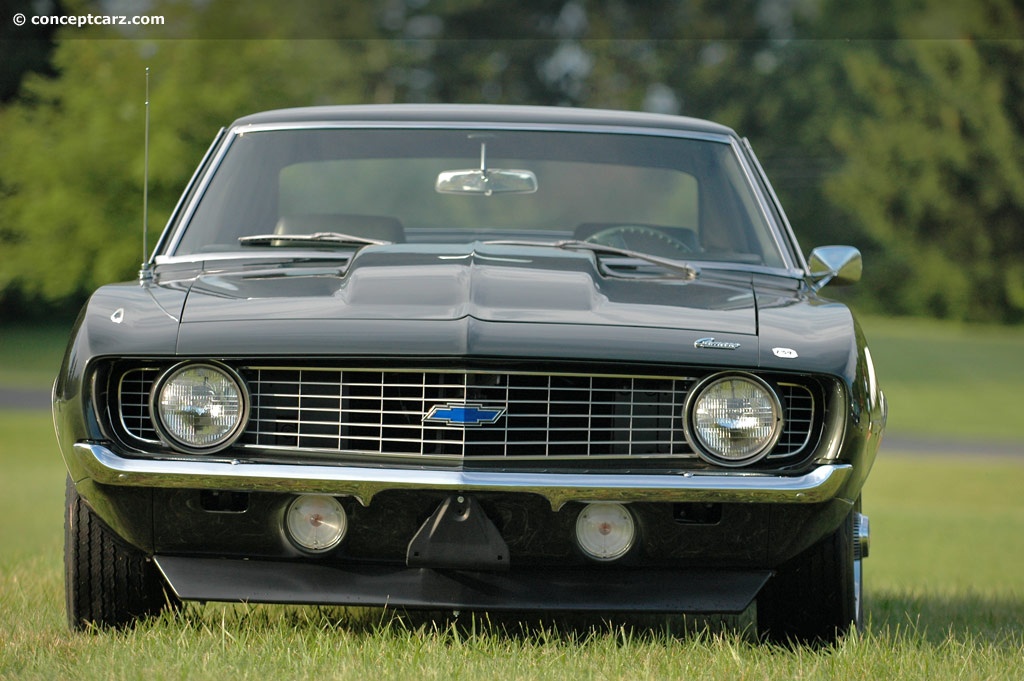
Hardtop Sport Coupe
View info and history
Fred Gibb was another Chevrolet dealer who convinced General Motors to create an all-aluminum version of the 427 cubic-inch engine. Intended for Super Stock drag racing, the fifty examples were needed to satisfy National Hot Rod Association homologation rules. Gibbs received all fifty cars and other dealers across the country received nineteen more.
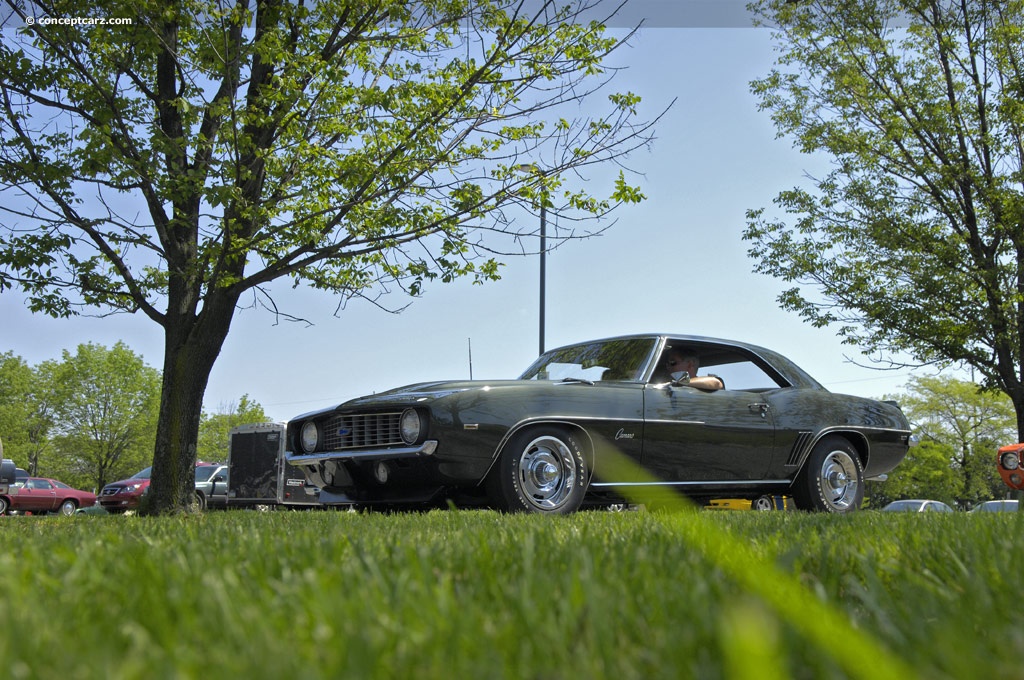
Hardtop Sport Coupe
View info and history
1968 Camaro
Chevrolet produced 159,087 examples of the 'base,' 40,977 of the RS, 27,884 of the SS, and 7,199 examples of the Z28. The total 1968 Chevy Camaro production was 235,147 units, which represented an increase over the 1967 production figure of 220,906 units.
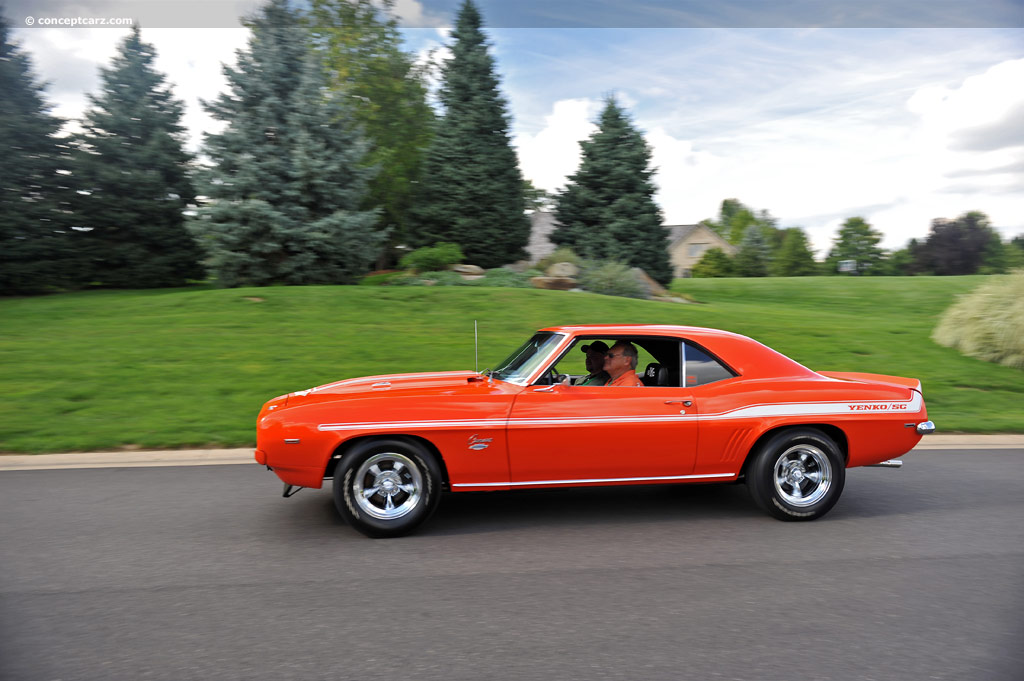
Hardtop Sport Coupe
View info and history
In 1969, Chevrolet produced 150,078 examples of the 'base,' 37,773 of the 'RS,' 34,932 of the SS, and 20,302 of the Z28. The total production of 1969 Camaros was 243,085 units, which represented an increase of nearly 8,000. Due to manufacturing problems that delayed the introduction of the second-generation model planned for 1970, the 1969 model year was longer than usual, extending into November 1969.Mechanical Specifications
Dimensions
The 1969 Chevy Camaro had a wheelbase size of 108 inches, a length of 186 inches, a width of 74 inches, and stood 51.1 inches tall (the convertible was 50.9 inches tall). Updates
The mounting for the rear shock absorber was staggered to resolve wheel hop issues on the 1968 Camaros, and examples with high-performance engines had received multi-leaf rear springs instead of the single-leaf unit.Engines
The 230 cubic-inch inline six-cylinder engine had overhead valves, a cast iron block, hydraulic valve lifters, seven main bearings, and a Rochester one-barrel carburetor. With 8.5:1 compression, it delivered 140 horsepower at 4,400 RPM and 220 lb-ft of torque.
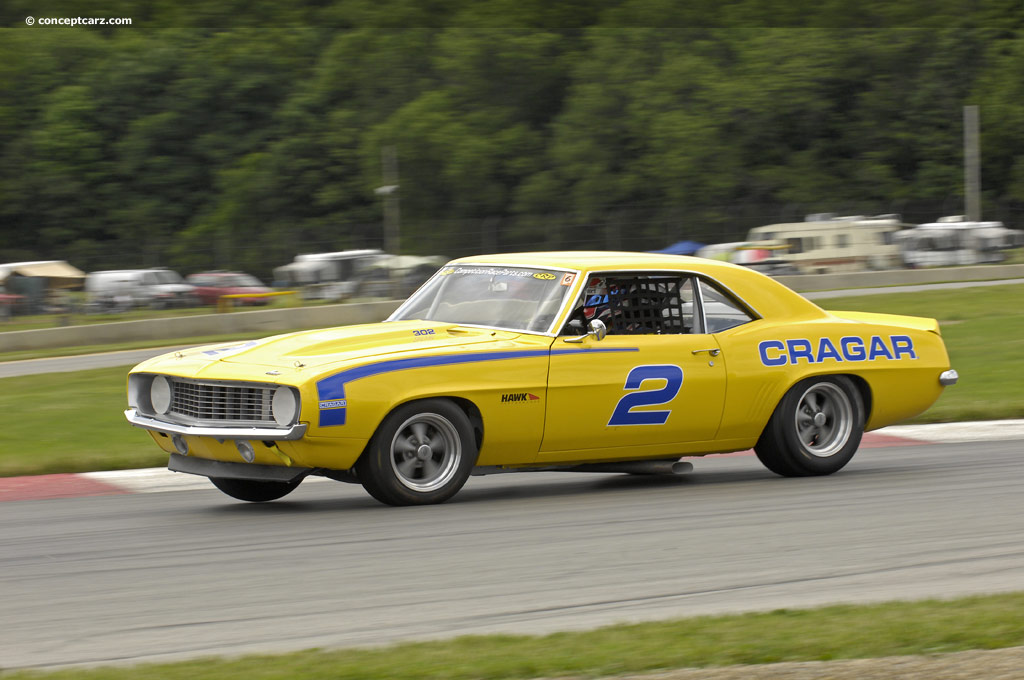
Hardtop Sport Coupe
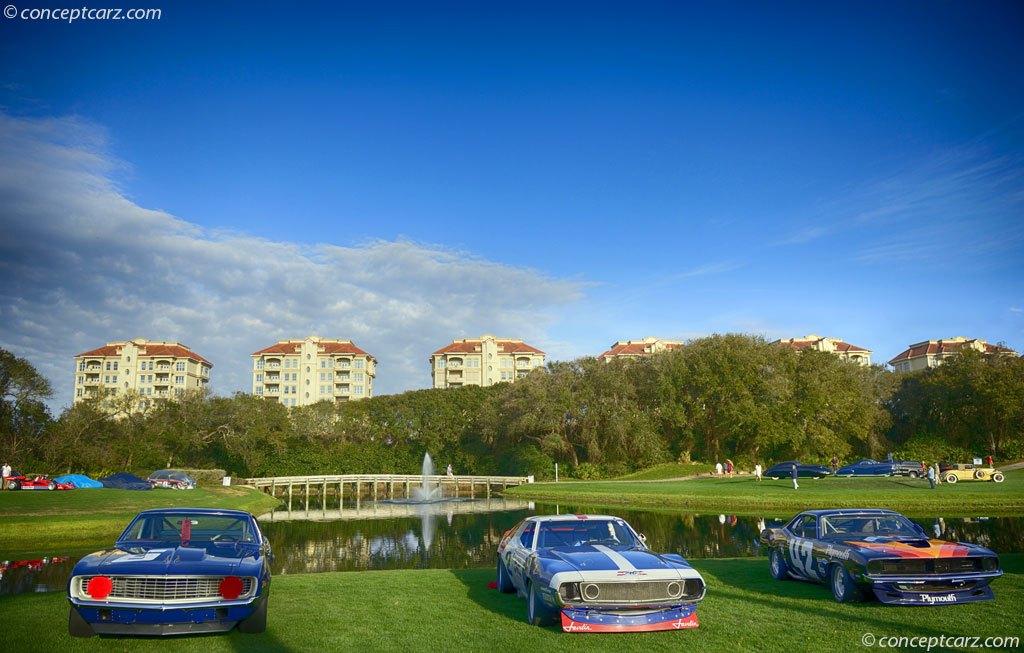
Hardtop Sport Coupe
View info and history
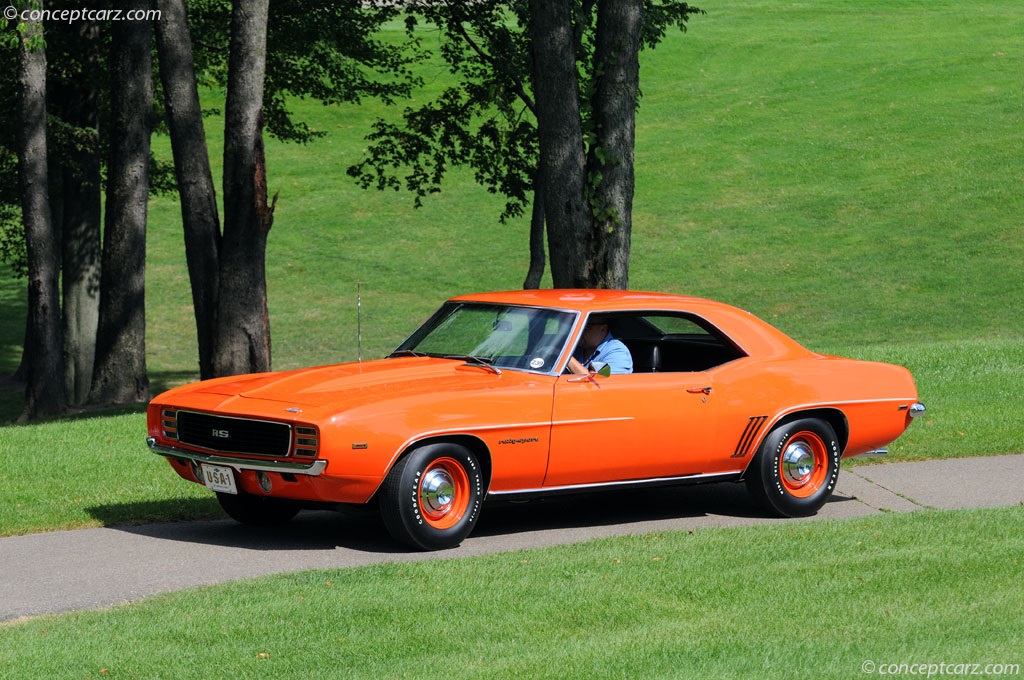
Hardtop Sport Coupe
View info and history
by Daniel Vaughan | Aug 2019
Related Reading : Chevrolet Camaro History
The Chevrolet Camaro was introduced in 1967 as a compact car specifically built to provide competition for the highly popular Ford Mustang. This pony car was built atop of the same F-Body platform as the Pontiac Firebird, which had a similar production lifespan of 1967 through 2002. During the preproduction stages of the Chevrolet Camaro, General Motors codenamed the vehicle Panther. The name....
Continue Reading >>
Continue Reading >>
- 1969 Chevrolet Camaro Menu
- Article
- Image gallery
- Valuation
- Specifications
- Profiles
- Recalls
- Production figures
- Accessories
Chevrolet
Similar Vehicles
Similar Automakers
Similarly Sized Vehicles
from 1969
- AMC AMX
AMC Javelin
Aston Martin DBS
Chevrolet Camaro Funny Car
Chevrolet El Camino
Chevrolet Reggie Jackson Camaro
DeTomaso Mangusta
Ford Mustang
Ford Mustang GT 350
Ford Mustang GT350 Hertz
Similarly Priced Vehicles
1969 Chevrolet Camaro Vehicle Profiles
Recent Vehicle Additions
Performance and Specification Comparison
Price Comparison
$2,240 - $2,435
$2,260 - $2,640
$2,380 - $3,195
$2,485 - $3,270
$2,614 - $2,762
$2,685 - $3,065
$2,910 - $3,465
$3,295 - $3,675
$4,425 - $4,765
Camaro Generation 1 Specification Comparison by Year
Year
Production
Wheelbase
Engine
Prices
220,906
108.10 in.
8 cyl., 263.00 CID., 195.00hp
8 cyl., 327.00 CID., 210.00hp
8 cyl., 302.00 CID., 290.00hp
8 cyl., 350.00 CID., 295.00hp
8 cyl., 396.00 CID., 350.00hp
8 cyl., 396.00 CID., 375.00hp
8 cyl., 327.00 CID., 210.00hp
8 cyl., 302.00 CID., 290.00hp
8 cyl., 350.00 CID., 295.00hp
8 cyl., 396.00 CID., 350.00hp
8 cyl., 396.00 CID., 375.00hp
$2,500 - $3,310
235,147
106.00 in.
6 cyl., 230.00 CID., 140.00hp
6 cyl., 250.00 CID., 155.00hp
8 cyl., 327.00 CID., 210.00hp
8 cyl., 327.00 CID., 250.00hp
8 cyl., 327.00 CID., 275.00hp
8 cyl., 302.00 CID., 290.00hp
8 cyl., 350.00 CID., 295.00hp
8 cyl., 396.00 CID., 325.00hp
8 cyl., 327.00 CID., 350.00hp
8 cyl., 395.31 CID., 375.00hp
6 cyl., 250.00 CID., 155.00hp
8 cyl., 327.00 CID., 210.00hp
8 cyl., 327.00 CID., 250.00hp
8 cyl., 327.00 CID., 275.00hp
8 cyl., 302.00 CID., 290.00hp
8 cyl., 350.00 CID., 295.00hp
8 cyl., 396.00 CID., 325.00hp
8 cyl., 327.00 CID., 350.00hp
8 cyl., 395.31 CID., 375.00hp
$2,600 - $3,797
243,085
108.00 in.
6 cyl., 230.00 CID., 140.00hp
6 cyl., 250.00 CID., 155.00hp
8 cyl., 307.00 CID., 200.00hp
8 cyl., 327.00 CID., 210.00hp
8 cyl., 350.00 CID., 255.00hp
8 cyl., 302.00 CID., 290.00hp
8 cyl., 350.00 CID., 300.00hp
8 cyl., 396.00 CID., 325.00hp
8 cyl., 396.00 CID., 350.00hp
8 cyl., 396.00 CID., 375.00hp
8 cyl., 427.00 CID., 430.00hp
6 cyl., 250.00 CID., 155.00hp
8 cyl., 307.00 CID., 200.00hp
8 cyl., 327.00 CID., 210.00hp
8 cyl., 350.00 CID., 255.00hp
8 cyl., 302.00 CID., 290.00hp
8 cyl., 350.00 CID., 300.00hp
8 cyl., 396.00 CID., 325.00hp
8 cyl., 396.00 CID., 350.00hp
8 cyl., 396.00 CID., 375.00hp
8 cyl., 427.00 CID., 430.00hp
$2,635 - $2,850
Related Automotive News

Barrett-Jackson's Scottsdale Auction Shifts into High Gear with Docket of Exceptional Big Block American Muscle, Including a 'Survivor' 1970 Plymouth Superbird and a 1967 Yenko Super Camaro
Barrett-Jackson, the Worlds Greatest Collector Car Auctions, is shifting into high gear with a docket of classic big block American muscle cars during the auction companys 50th anniversary celebration at WestWorld of Scottsdale, January 22-30. Leading...

GENERAL MOTORS GALORE AT MECUM KISSIMMEE 2016
69 Trans Am Convertibles, 69 ZL1s and Featured Corvettes at Auction, Jan. 15-24
Walworth, Wis. – Jan. 12, 2016 – As the worlds largest collector-car auction featuring 3,000 vehicles, Mecum Kissimmee is unequaled in its variety of mak...

Rare and Highly Sought After AMC Javelin at Russo and Steele Newport Beach!
Scottsdale, Arizona (April 2nd, 2015) – For Enthusiasts – By Enthusiasts.™ Much more than a tagline, its our lifestyle and its one that infuses all aspects of our auction events. Fresh off a thrilling, action packed and highly memorable Scottsdale...

The Crescendo Effect: As the Days Get Closer, The Cars Get Bigger at Russo and Steele's 15th Anniversary Auction Event!
Scottsdale, Arizona (January 6th, 2015) – For Enthusiasts – By Enthusiasts. ™ This is far more than a tagline at Russo and Steele Collector Automobile Auctions. Its a lifestyle, and we are gearing up to deliver that singular passion to the High Desert...
RRDC VOTES IN 37 NEW MEMBERS FOR 2013
HILLIARD, Ohio (Nov. 7, 2013) - Thirty-seven race-car drivers and motorsports professionals have been voted into the Road Racing Drivers Club in 2013. The group includes 13 Regular Members from the open-wheel and sports-car racing ranks, 20 Associate...











































